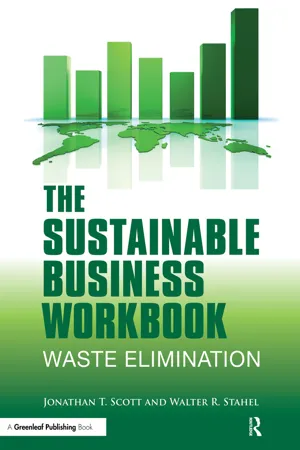
The Sustainable Business Workbook
A Practitioner's Guide to Achieving Long-Term Profitability and Competitiveness
Jonathan T. Scott, Walter R. Stahel
- 30 pages
- English
- ePUB (mobile friendly)
- Available on iOS & Android
The Sustainable Business Workbook
A Practitioner's Guide to Achieving Long-Term Profitability and Competitiveness
Jonathan T. Scott, Walter R. Stahel
About This Book
Whether you are undertaking the exercises for your own purposes or with the intent of completing a certification course in sustainable development, this workbook will be of help. The companion text for this publication is The Sustainable Business: A Practitioner's Guide to Achieving Long-Term Profitability and Competitiveness (2nd edition). Read the companion text thoroughly before beginning this workbook. Follow a step-by-step approach using the 7-P Roadmap to Sustainability Model and work your way through the seven sections that comprise the companion text (Preparation, Processes, Preservation, People, Place, Product and Production). This workbook focuses on Waste Elimination. A forthcoming workbook will focus on Resource Extension. This workbook will increase your knowledge and understanding, subject-specific skills and personal and transferable skills.
Frequently asked questions
Preparation
Energy
External: Market price assessment
- Create a graph similar to the one below and record the past, present and estimated future market prices of the various forms of energy used by your business.
Energy prices

Internal: Costs assessment
- 2. Create a graph similar to the one below and record your business’s total energy costs.
Energy consumption

Raw materials or system inputs
External: Market cost assessment
- 3. Create a graph similar to the one below and record the current price and estimated future market price of select raw materials used by your business. (Note: code words or letters substituted for the names of raw materials can be used to maintain confidentiality.)
Raw material (or system input) costs

Internal: Cost assessment
- 4. Create a graph similar to the one below and record your business’s raw material or system input costs. (Note: code words or letters substituted for the names of raw materials can be used.)
Raw material (or system input) costs

Waste disposal costs
- 5. Create a graph similar to the one below. Record your business’s annual waste disposal costs.
Total internal annual waste

Changes in waste legislation
- 6. Using the examples in Chapter 1: ‘Changes in waste legislation’ (in the course text) as a starting point, list any waste and disposal laws that currently affect your business.
- 7. Next to each law, describe any changes that may be imposed in the future (for example: could the laws become stricter? If so, how?).
- 8. Describe any current trends that could influence pending or possible future waste disposal legislation. Explain the reasons why such laws could be imposed and the effect each new law would have on your business.
Changes in environmental laws
- 9. List the environmental laws that currently affect your business. Next to each law, acknowledge any foreseen future changes that may be imposed (for example: could these laws become stricter? If so, how?).
- 10. Describe any pending or possible future environmental legislation that could affect your business – as well as the reasons why such laws could be imposed.
Raw material procurement
- 11. List and describe your business’s weaknesses in terms of resource scarcity (e.g. raw materials, labour, etc…). Include possible solutions for each.
- 12. List any additional risk factor problems your business could face in terms of its required resources. Risk factors can include: changes in legislation, climate change, the distance the resources travel (and/or the methods of travel), the origins of the resources (political risk), etc. Describe possible solutions for each.
Changes in customer expectations and demands
- 13. What do your employees currently think about sustainability? Explain.
- 14. Briefly describe your ...